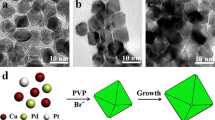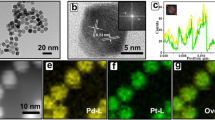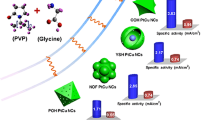Abstract
Nanomagnetic CoPt truncated octahedral nanoparticles (TONPs) were successfully synthesised through a facile one-pot strategy. These single crystal CoPt TONPs with an average size of about 8 nm exhibit excellent electrocatalytic performance of both activity and stability for methanol oxidation reaction (MOR). The mass and specific activities of CoPt TONPs is 8 and 6 times higher than that of standard commercial Pt/C, respectively. After accelerated durability test (ADT), the loss of electrochemical surface area (ECSA) for CoPt TONPs is only 18.5%, which is significantly less than that of commercial Pt/C (68.2%), indicating that CoPt TONPs possess much better stability than commercial Pt/C in the prolonged operation. The Curie temperature of CoPt TONPs down to 8 nm is as high as 350 K with weak ferromagntism at room temperature (RT), which is greatly valuable for recycling in the eletrocatalytic applications.
摘要
本文通过简单的一步法成功制备出室温铁磁性CoPt纳米截角八面体. 这种平均大小约为8 nm的单晶CoPt截角八面体纳米结构在催化甲醇氧化反应时表现出优异的电催化活性及稳定性, 其质量活性和相对比活性分别能够达到标准商业Pt/C催化剂的8倍及6倍. 长时间加速稳定性测试结果表明, CoPt纳米截角八面体的电化学活性表面积仅损失了18.5%, 而相同反应条件下的标准商业Pt/C电极却损失了68.2%.磁性分析发现, 这些仅有8 nm大小的CoPt纳米截角八面体的居里温度高达350 K, 并在室温下表现出较弱的铁磁性, 这将更加有利于催化剂的回收再利用, 在实际应用中具有较大的潜在价值.
Similar content being viewed by others
References
Zhao X, Zhang J, Wang L, et al. Ultrathin PtPdCu nanowires fused porous architecture with 3D molecular accessibility: an active and durable platform for methanol oxidation. ACS Appl Mater Interfaces, 2015, 7: 26333–26339
Du X, Luo S, Du H, et al. Monodisperse and self-assembled Pt-Cu nanoparticles as an efficient electrocatalyst for themethanol oxidation reaction. J Mater Chem A, 2016, 4: 1579–1585
Liu H, Nosheen F, Wang X. Noble metal alloy complex nanostructures: controllable synthesis and their electrochemical property. Chem Soc Rev, 2015, 44: 3056–3078
Chung DY, Jun SW, Yoon G, et al. Highly durable and active PtFe nanocatalyst for electrochemical oxygen reduction reaction. J Am Chem Soc, 2015, 137: 15478–15485
Jung N, Bhattacharjee S, Gautam S, et al. Organic-inorganic hybrid PtCo nanoparticle with high electrocatalytic activity and durability for oxygen reduction. NPG Asia Mater, 2016, 8: e237
Stamenkovic VR, Fowler B, Mun BS, et al. Improved oxygen reduction activity on Pt3Ni(111) via increased surface site availability. Science, 2007, 315: 493–497
Huang W, Wang H, Zhou J, et al. Highly active and durable methanol oxidation electrocatalyst based on the synergy of platinum- nickel hydroxide-graphene. Nat Commun, 2015, 6: 10035
Vinayan BP, Ramaprabhu S. Platinum-TM (TM = Fe, Co) alloy nanoparticles dispersed nitrogen doped (reduced graphene oxidemultiwalled carbon nanotube) hybrid structure cathode electrocatalysts for high performance PEMFC applications. Nanoscale, 2013, 5: 5109–5118
Bu L, Ding J, Guo S, et al. A general method for multimetallic platinum alloy nanowires as highly active and stable oxygen reduction catalysts. Adv Mater, 2015, 27: 7204–7212
Xia BY, Wu HB, Li N, et al. One-pot synthesis of Pt-Co alloy nanowire assemblies with tunable composition and enhanced electrocatalytic properties. Angew Chem Int Ed, 2015, 54: 3797–3801
Mani P, Srivastava R, Strasser P. Dealloyed binary PtM3 (M=Cu, Co, Ni) and ternary PtNi3M(M=Cu, Co, Fe, Cr) electrocatalysts for the oxygen reduction reaction: performance in polymer electrolyte membrane fuel cells. J Power Sources, 2011, 196: 666–673
Yang P, Jin SY, Xu QZ, et al. Decorating PtCo bimetallic alloy nanoparticles on graphene as sensors for glucose detection by catalyzing luminol chemiluminescence. Small, 2013, 9: 199–204
Xu Y, Yuan Y, Ma A, et al. Composition-tunable Pt-Co alloy nanoparticle networks: facile room-temperature synthesis and supportless electrocatalytic applications. Chem Phys Chem, 2012, 13: 2601–2609
Huang Y, Garcia M, Habib S, et al. Dealloyed PtCo hollow nanowires with ultrathin wall thicknesses and their catalytic durability for the oxygen reduction reaction. J Mater Chem A, 2014, 2: 16175–16180
Li C, Imura M, Yamauchi Y. Displacement plating of amesoporous Pt skin onto Co nanochains in a low-concentration surfactant solution. Chem Eur J, 2014, 20: 3277–3282
Zhu J, Wu J, Liu F, et al. Controlled synthesis of FePt-Au hybrid nanoparticles triggered by reaction atmosphere and FePt seeds. Nanoscale, 2013, 5: 9141–9149
Yuan Q, Zhuang J, Wang X. Single-phase aqueous approach toward Pd sub-10 nm nanocubes and Pd-Pt heterostructured ultrathin nanowires. Chem Commun, 2009, 43: 6613
Cui C, Gan L, Heggen M, et al. Compositional segregation in shaped Pt alloy nanoparticles and their structural behaviour during electrocatalysis. Nat Mater, 2013, 12: 765–771
Yang T, Cao G, Huang Q, et al. Truncated octahedral platinumnickel-iridium ternary electro-catalyst for oxygen reduction reaction. J Power Sources, 2015, 291: 201–208
Alam A, Kraczek B, Johnson DD. Structural, magnetic, and defect properties of Co-Pt-type magnetic-storage alloys: density-functional theory study of thermal processing effects. Phys Rev B, 2010, 82: 024435
Khemjeen Y, Pinitsoontorn S, Chompoosor A. Effect of boron addition on the structure and magnetic properties of CoPt nanoparticles. J Appl Phys, 2015, 117: 17D513
Saravanan P, Hsu JH, Tsai CL, et al. Interplay between out-of-plane anisotropic L11-type CoPt and in-plane anisotropic NiFe layers in CoPt/NiFe exchange springs. J Appl Phys, 2014, 115: 243905
Alloyeau D, Ricolleau C, Mottet C, et al. Size and shape effects on the order-disorder phase transition in CoPt nanoparticles. Nat Mater, 2009, 8: 940–946
Liu J, Xia T, Wang S, et al. Oriented-assembly of hollow FePt nanochains with tunable catalytic and magnetic properties. Nanoscale, 2016, 8: 11432–11440
Yu Y, Yang W, Sun X, et al. Monodisperse MPt (M = Fe, Co, Ni, Cu, Zn) nanoparticles prepared from a facile oleylamine reduction of metal salts. Nano Lett, 2014, 14: 2778–2782
Zheng JN, He LL, Chen C, et al. One-pot synthesis of platinum3cobalt nanoflowers with enhanced oxygen reduction and methanol oxidation. J Power Sources, 2014, 268: 744–751
Xu J, Liu X, Chen Y, et al. Platinum-cobalt alloy networks for methanol oxidation electrocatalysis. J Mater Chem, 2012, 22: 23659–23667
Tseng YC, Chen HS, Liu CW, et al. The effect of alloying on the oxygen reduction reaction activity of carbon-supported PtCu and PtPd nanorods. J Mater Chem A, 2014, 2: 4270–4275
Wagner CD, Muilenberg GE. Handbook of X-ray Photo-Electron Spectroscopy. Minnesota: Perkin-Elmer Corporation, 1979
Sun X, Jiang K, ZhangN, et al. Crystalline control of {111} bounded Pt3Cu nanocrystals: multiply-twinned Pt3Cu icosahedra with enhanced electrocatalytic properties. ACS Nano, 2015, 9: 7634–7640
Chen C, Kang Y, Huo Z, et al. Highly crystalline multimetallic nanoframes with three-dimensional electrocatalytic surfaces. Science, 2014, 343: 1339–1343
Xia T, Liu J, Wang S, et al. Enhanced catalytic activities of NiPt truncated octahedral nanoparticles toward ethylene glycol oxidation and oxygen reduction in alkaline electrolyte. ACS Appl Mater Interfaces, 2016, 8: 10841–10849
Tan XH, Prabhudev S, KohandehghanA, et al. Pt-Au-Co alloy electrocatalysts demonstrating enhanced activity and durability toward the oxygen reduction reaction. ACS Catal, 2015, 5: 1513–1524
Cui C, Gan L, Li HH, et al. Octahedral PtNi nanoparticle catalysts: exceptional oxygen reduction activity by tuning the alloy particle surface composition. Nano Lett, 2012, 12: 5885–5889
Dai L, Zhao Y, Chi Q, et al. Morphological control and evolution of octahedral and truncated trisoctahedral Pt-Au alloy nanocrystals under microwave irradiation. Nanoscale, 2014, 6: 9944–9950
Fu QQ, Li HH, Ma SY, et al. A mixed-solvent route to unique PtAuCu ternary nanotubes templated from Cu nanowires as efficient dual electrocatalysts. Sci China Mater, 2016, 59: 112–121
Shan A, Chen Z, Li B, et al. Monodispersed, ultrathin NiPt hollow nanospheres with tunable diameter and composition via a green chemical synthesis. J Mater Chem A, 2015, 3: 1031–1036
Fu S, Zhu C, Shi Q, et al. Highly branched PtCu bimetallic alloy nanodendrites with superior electrocatalytic activities for oxygen reduction reactions. Nanoscale, 2016, 8: 5076–5081
Hu C, Han Q, Zhao F, et al. Graphitic C3N4-Pt nanohybrids supported on a graphene network for highly efficient methanol oxidation. Sci China Mater, 2015, 58: 21–27
Wang S, Yang G, Yang S. Pt-frame@Ni quasi core-shell concave octahedral PtNi3 bimetallic nanocrystals for electrocatalytic methanol oxidation and hydrogen evolution. J Phys Chem C, 2015, 119: 27938–27945
Wang DY, Chou HL, Lin YC, et al. Simple replacement reaction for the preparation of ternary Fe1–x PtRux nanocrystals with superior catalytic activity in methanol oxidation reaction. J Am Chem Soc, 2012, 134: 10011–10020
Liu H, Adzic RR, Wong SS. Multifunctional ultrathin PdxCu1–x and Pt~PdxCu1–x one-dimensional nanowire motifs for various small molecule oxidation reactions. ACS Appl Mater Interfaces, 2015, 7: 26145–26157
Lai S, Fu C, Chen Y, et al. Pt-content-controlled synthesis of Pd nanohollows/Pt nanorods core/shell composites with enhanced electrocatalytic activities for the methanol oxidation reaction. J Power Sources, 2015, 274: 604–610
Chen Q, Zhang J, Jia Y, et al. Wet chemical synthesis of intermetallic Pt3Zn nanocrystals via weak reduction reaction together with UPD process and their excellent electrocatalytic performances. Nanoscale, 2014, 6: 7019–7024
Cai Z, Kuang Y, Qi X, et al. Ultrathin branched PtFe and PtRuFe nanodendrites with enhanced electrocatalytic activity. J Mater Chem A, 2015, 3: 1182–1187
Zhao ZL, Zhang LY, Bao SJ, et al. One-pot synthesis of small and uniform Au@PtCu core-alloy shell nanoparticles as an efficient electrocatalyst for direct methanol fuel cells. Appl Catal B-Environ, 2015, 174–175: 361–366
Shan A, Liu W, Wang R, et al. Magnetism in undoped ZnS nanotetrapods. Phys Chem Chem Phys, 2013, 15: 2405–2410
Sun Q, Wang S, Wang R. Well-alignedCoPt hollownanochains synthesized in water at room temperature. J Phys Chem C, 2012, 116: 5352–5357
Wang W, Yan LQ, Cong JZ, et al. Magnetoelectric coupling in the paramagnetic state of a metal-organic framework. Sci Rep, 2013, 3: 2024
Shaw JM, Nembach HT, Silva TJ, et al. Precise determination of the spectroscopic g-factor by use of broadband ferromagnetic resonance spectroscopya. J Appl Phys, 2013, 114: 243906
Ulmeanu M, Antoniak C, Wiedwald U, et al. Composition-dependent ratio of orbital-to-spin magnetic moment in structurally disordered FexPt1−x nanoparticles. Phys Rev B, 2004, 69: 054417
Acknowledgments
This work was supported by the National Basic Research Program of China (2015CB921401), the National Instrument Program of China (2012YQ120048), the National Natural Science Foundation of China (51625101, 51431009, 51471183, 51331002, 51371015, 11274371, 11674023), the Instrument Development Program of Chinese Academy of Sciences (YZ201345), and the Fundamental Research Funds for the Central Universities (FRF-BR-15-009B).
Author information
Authors and Affiliations
Corresponding authors
Additional information
Tianyu Xia received her master degree from the Capital Normal University in 2013. She is now a PhD student supervised by Prof. Shouguo Wang and RongmingWang in Beihang University. Her current research is focused on the synthesis and characterization of noble nanomaterials.
Shouguo Wang received his bachelor degree (1996) from Anhui University and PhD (2001) from the Institute of Solid State Physics, Chinese Academy of Sciences (CAS), respectively. From August 2001 to December 2007, he did his research at the National University of Singapore, Max-Planck-Institute of Microstructure Physics, and the Univerity of Oxford. At the end of 2007, he joined the State Key Laboratory of Magnetism, Institute of Physics-CAS. He moved to the School of Materials Science and Engineering, University of Science and Technology Beijing in January 2016. His research interests include the magnetism and magnetic materials, with a focus on the topological magnetism such as skyrmions, spintronics, and nanomagnetism.
Rongming Wang received his bachelor (1991) and masterʼs (1994) degrees in physics from Peking University and PhD (1997) in materials science from Beijing Institute of Aeronautical Materials (BIAM), China. He joined Peking University as an associate professor in 2002. He joined Beihang University as a professor of physics in 2005 and joined the University of Science and Technology Beijing in 2015. His research interests include the synthesis, atomic structure and properties of functional nanomaterials. He has co-authored over 160 peer reviewed papers and has a research H-index of 39.
Electronic supplementary material
40843_2016_5139_MOESM1_ESM.pdf
Nanomagnetic CoPt truncated octahedrons: facile synthesis, superior electrocatalytic activity and stability for methanol oxidation
Rights and permissions
About this article
Cite this article
Xia, T., Liu, J., Wang, S. et al. Nanomagnetic CoPt truncated octahedrons: facile synthesis, superior electrocatalytic activity and stability for methanol oxidation. Sci. China Mater. 60, 57–67 (2017). https://doi.org/10.1007/s40843-016-5139-y
Received:
Accepted:
Published:
Issue Date:
DOI: https://doi.org/10.1007/s40843-016-5139-y




